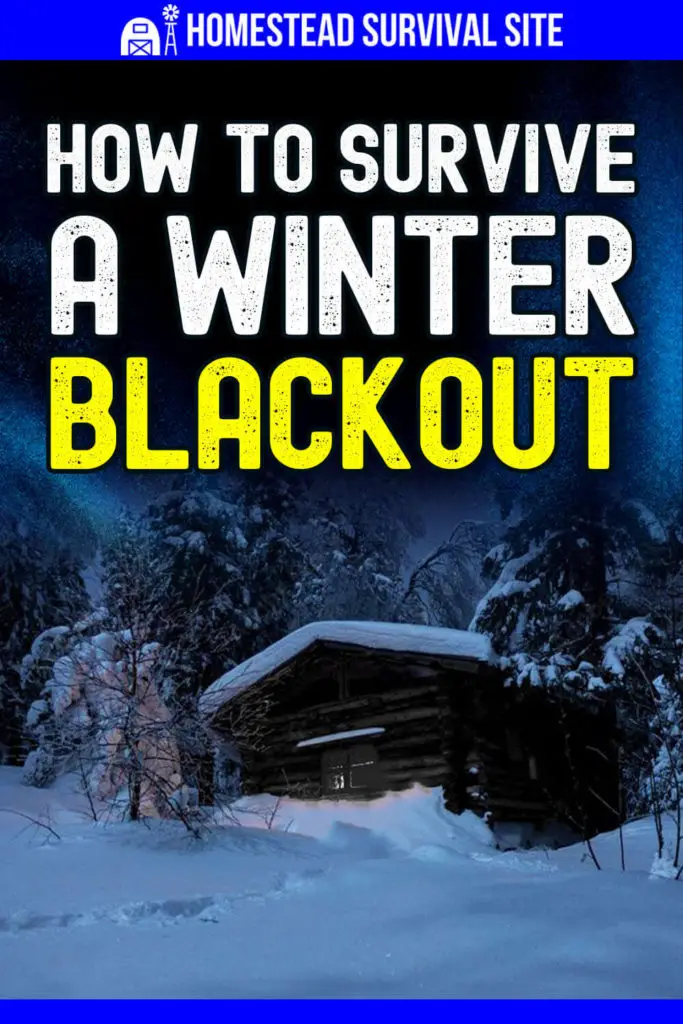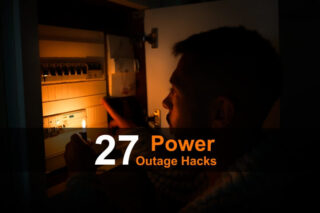Estimated reading time: 8 minutes
Russian attacks on Ukraine’s energy systems have forced civilians across the country to deal with extended power outages. In the chill of late October, more than a million households were without power due to a wave of so-called “kamikaze” drone attacks.
As Ukrainian civilians face this latest challenge with courage and resolve, we can learn from the preparations they have taken and are making. After all, although losing electricity can be difficult at any time, it can be especially punishing in cold weather. Not only do our bodies suffer when temperatures dip, but pipes can freeze, limiting our access to water and damaging our homes.
This article will explore the preparations you should make now to be ready for a winter blackout and what to do after the power goes out.
Want to save this post for later? Click Here to Pin It On Pinterest!
- What To Do Before The Power Goes Out
- 1. Weatherize Your Home
- 2. Protect Your Pipes
- 3. Have Plenty of Battery Power
- 4. Purchase a Generator
- 5. Maintain a Full Tank of Gas
- 6. Have Phone Chargers in Your Vehicles
- 7. Consider Alternative Heating, Cooling, and Lighting Sources
- 8. Stock Up On Non-perishable Food
- 9. Have Water Ready
- 10. Install Thermometers in Your Refrigerator and Freezer
- 11. Install a Carbon Monoxide Detector
- 12. Stay Informed
- What To Do When The Power Goes Out
What To Do Before The Power Goes Out
Here are steps you should take now to be ready for a potential blackout this winter.
1. Weatherize Your Home
When the power goes out, you want your home to hold as much indoor heat as possible while keeping out as much outdoor cold as possible.
Use weatherstripping to seal cracks in doorways and window sills. Consider adding more insulation in your attic and crawlspaces. Upgrade old windows and doors with more energy-efficient replacements.
2. Protect Your Pipes
Cold temperatures can cause water in your pipes to freeze. The expansion that results can lead to burst pipes and extensive damage. Check for pipes that run through unheated spaces or outside-facing walls and insulate them. Allowing a trickle of water to run through the lines can keep them from freezing.
3. Have Plenty of Battery Power
Batteries are essential during a blackout. Make sure you have enough batteries on hand for your flashlights and electronics. And know where these items are.
Keep chargers – especially phone and laptop chargers – at full power.
Although you hopefully can continue to rely on your phone in an emergency, it’s wise to have a battery-powered or hand-cranked radio on hand for when the power goes out.
4. Purchase a Generator
Back-up generators can vary in size and power, from being able to run your whole house to only a few electronics. Whatever generator fits your needs and your budget, be sure to follow operation guidelines carefully. Most operate with propane or gasoline and must be placed at least 15 feet away from your home.
5. Maintain a Full Tank of Gas
Since most gas pumps run on electricity, gas stations can be closed during a widespread power outage. Keep your tank as full as possible.
6. Have Phone Chargers in Your Vehicles
Your car battery can be an excellent source of power for your phone during a blackout. Be sure to have the correct chargers for your cars.
7. Consider Alternative Heating, Cooling, and Lighting Sources
Since even gas furnaces use electric starters, think about adding a battery back-up for an electric starter. Stock up on wood for fireplaces and woodstoves and fuel for fuel heaters, cook stoves, and grills.
Even in your gas stove has an electric starter, you may be able to ignite it manually. Turn a burner knob to low and hold a match to it. Then adjust the flame as necessary. Use extreme caution.
Candles and lanterns are good sources of light during a power outage. Once again, use caution. For example, to avoid fire danger, use candle holders and place candles well away from flammable items, such as curtains. Do not leave candles burning in unoccupied rooms or when you are sleeping.
And do not use an oven or stove to heat your home.
8. Stock Up On Non-perishable Food
A prolonged outage can mean spoiled food in the refrigerator and freezer. Make sure you have canned goods, cereals, dried fruits and nuts, and other non-perishable foods on hand.
9. Have Water Ready
Electric outages can affect the municipal water supply and the pumps for wells. Each person in your family needs at least a gallon of water per day, so make sure you have a supply of water stored for an emergency.
Freezing containers of water in the freezer will not only help keep things cold, but the melting ice will supply clean drinking water when the power goes out. Filling up the bathtub with water before a storm also helps provide a supply of water.
10. Install Thermometers in Your Refrigerator and Freezer
You can’t always rely on appearance and color when it comes to knowing if a food is safe to eat after an outage.
If the freezer thermometer reads 40°F or below, and the food still contains ice crystals, it usually is safe and may be refrozen.
Discard perishable food (poultry, meat, seafood, eggs, milk, and leftovers) that has been stored in refrigerator temperatures above 40°F for four hours or more. Other perishable food should be cooked or consumed as soon as possible.
For times when you don’t know how long the power has been out, you could try the “quarter on a cup” method. Freeze a cup of water, then place a quarter on top of the ice. If the quarter has sunk more than half an inch down, your food has been exposed to warm temperatures for an unsafe period.
Here’s a video on food safety during a power outage.
11. Install a Carbon Monoxide Detector
Carbon monoxide is a silent killer. The invisible, odorless gas is produced when you don’t completely burn off fuels like wood, natural gas, oil, propane, kerosene, or coal.
So, you may be more susceptible to carbon monoxide poisoning during a power outage. If the detector is electric-powered, make sure it has a battery back-up power supply.
12. Stay Informed
If weather conditions or other threats indicate that a power outage is imminent, don’t wait to get ready. Follow news updates and get the supplies you need in place before you are left in the dark.
What To Do When The Power Goes Out
Even if you’ve taken all the steps above, there are still more things you should do right after the blackout occurs.
1. Determine The Source of The Outage
Power outages could be caused by many things, such as extreme weather, power overload, equipment failure, seismic activity, unsafe digging or, as we have seen in Ukraine, warfare.
If you are unsure of the cause, you can take simple steps to see if the outage is a problem in just your house, such as a tripped breaker, or is affecting other homes. Here are some ideas:
- If it is dark out, check if you can see lights on at your neighbors’ homes.
- If nearby lights are on, investigate your fuses and breakers. Simply flipping the breaker may restore the problems. If the breaker continues to trip, get help from an electrician.
- If the outage is not just at your home, use your phone to check in with your local power company’s website. You may be able to get news of the outage and when power is expected to be restored.
- Do not go near a downed power line. Alert your utility company of downed lines or exposed electrical wires.
2. Unplug Electronics
Protect your devices and appliances from surges when the power returns by unplugging them. Wait for restored consistent electricity before plugging them back in.
Also, turn off the appliances you were using when the power outage occurred. For example, if you were cooking, turn off burners to prevent a safety hazard when power is restored.
3. Condense Your Living Space
The smaller the space, the easier it is to keep warm. Gather your family in the room that has a fireplace or wood stove and close off other rooms. Body heat also helps.
Ideally, this room should have few windows and located on the south side of the home for maximum daytime sunlight. Close draperies at night to help conserve heat, perhaps adding blankets over the windows for extra insulation.
Don’t forget to have power-free activities on hand to keep yourselves busy. Suggestions include coloring books and crayons, pen and paper, puzzles, and reading material.
4. Layer Clothing
Set aside layers of clothing (including hats, gloves, and mittens), sleeping bags, pillows, bedding, and blankets in your condensed living space.
5. Keep Refrigerator and Freezer Doors Shut
Food will stay safe for up to four hours in a refrigerator and 48 hours in a full freezer or 24 hours in a half-full freezer.
6. Use a Generator
Follow directions closely for safety, and keep the generator outdoors and away you’re your home’s doors and windows to prevent dangerous exhaust gases from entering your home.
7. Conserve Battery Power
Since you can never be sure how long an outage will last, don’t waste precious battery power by playing games or scrolling social media on your phone. Turn off unneeded apps and background screens that might be draining energy.
8. Save Water
A power outage and the conditions that caused it can affect your water supply. Also, you will lose hot water if you have an electric water heater or a gas heater that has an electric starter.
Start using water sparingly, limiting toilet flushes and washing, for example, to help keep your supply running longer. Keeping baby wipes and hand sanitizer on hand can help you conserve water.
Assembling a power outage survival kit can help remove some worries from this potential situation. You can gather and place many helpful times we’ve listed in this article and place them in a container that’s easy to grab when the need arises.
Like this post? Don't Forget to Pin It On Pinterest!
You May Also Like:












A pure sine wave inverter is handy to have. Hook it up to your running vehicle’s battery. Most modern appliances have circuit boards. A regular generator can damage them.
By rotating power uses. You can run the refrigerator, freezer and even your furniture ( pre wiring required)
No worries about fresh fuel in your generator or if it will start.